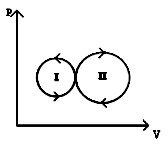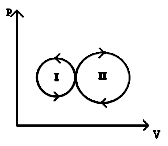For the indicator diagram given below to select the wrong statement.

| 1. | Cycle - II is a heat engine cycle |
| 2. | Net work is done on the gas in cycle - I |
| 3. | Work done is positive for the cycle I |
| 4. | Work done is positive for the cycle - II |
नीचे दिए गए संकेत आरेख के लिए गलत कथन का चयन कीजिए।

| 1. | चक्र - II एक ऊष्मीय इंजन चक्र है |
| 2. | चक्र - I में गैस पर परिणामी कार्य किया जाता है |
| 3. | चक्र - I के लिए किया गया कार्य धनात्मक है |
| 4. | चक्र - II के लिए किया गया कार्य धनात्मक है |
An ideal gas is taken from point A to the point B, as shown in the P-V diagram. The work done in the process is -
1.
2.
3.
4.
एक आदर्श गैस को बिंदु A से बिंदु B तक ले जाया जाता है, जैसा कि P-V आरेख में दिखाया गया है। प्रक्रम में किया गया कार्य है:
1.
2.
3.
4.
The P-V diagram shows seven curved paths (connected by vertical paths) that can be followed by a gas. Which two of them should be parts of a closed cycle if the net work done by the gas is to be at its maximum value
1. ac
2. cg
3. af
4. cd
P-V आरेख सात वक्र पथों (ऊर्ध्वाधर पथों से जुड़े हुए) को दर्शाता है जिसका अनुसरण एक गैस द्वारा किया जा सकता है। यदि गैस द्वारा किया गया परिणामी कार्य अधिकतम हो तो उनमें से कौन से दो पथ एक बंद चक्र के भाग होने चाहिए?
1. ac
2. cg
3. af
4. cd
The volume (V) of a monatomic gas varies with its temperature (T), as shown in the graph. The ratio of work done by the gas, to the heat absorbed by it, when it undergoes a change from state A to state B, is:
1.
2.
3.
4.
जैसा कि आरेख में दर्शाया गया है कि एकपरमाणुक गैस का आयतन (V) तापमान (T) के साथ परिवर्तित होता है। जब इसकी अवस्था A से B तक परिवर्तित होती है, तब गैस द्वारा किये गए कार्य का गैस द्वारा अवशोषित ऊष्मा के साथ अनुपात है:
1.
2.
3.
4.
If the ratio of specific heat of a gas at constant pressure to that at constant volume is γ, the change in internal energy of a mass of gas, when the volume changes from V to 2V constant pressure p, is
1.
2. pV
3.
4.
यदि किसी गैस की नियत दाब पर विशिष्ट ऊष्मा से नियत आयतन पर विशिष्ट ऊष्मा का अनुपात γ है, तो जब नियत दाब p पर आयतन V से 2V तक परिवर्तित होता है, गैस के द्रव्यमान की आंतरिक ऊर्जा में परिवर्तन है:
1.
2. pV
3.
4.
Carbon monoxide is carried around a closed cycle abc in which bc is an isothermal process as shown in the figure. The gas absorbs 7000 J of heat as its temperature increases from 300 K to 1000 K in going from a to b. The quantity of heat rejected by the gas during the process ca is -
| 1. | 4200 J | 2. | 5000 J |
| 3. | 9000 J | 4. | 9800 J |
कार्बन मोनोऑक्साइड को एक बंद चक्र abc में ले जाया जाता है जिसमें bc एक समतापीय प्रक्रम है जैसा कि आकृति में दिखाया गया है। a से b तक जाने में गैस 7000 J ऊष्मा अवशोषित करती है जब इसका तापमान 300 K से 1000 K तक बढ़ जाता है। प्रक्रम ca के दौरान गैस द्वारा निष्कासित ऊष्मा की मात्रा है -
| 1. | 4200 J | 2. | 5000 J |
| 3. | 9000 J |
4. | 9800 J |
The temperature-entropy diagram of a reversible engine cycle is given in the figure. Its efficiency is
| 1. | 1/3 | 2. | 2/3 |
| 3. | 1/2 |
4. | 1/4 |
उत्क्रमणीय इंजन चक्र का तापमान-एन्ट्रॉपी आरेख आकृति में दिया गया है। इसकी दक्षता है :
| 1. | 1/3 | 2. | 2/3 |
| 3. | 1/2 |
4. | 1/4 |
A cyclic process for 1 mole of an ideal gas is shown in figure in the V-T, diagram. The work done in AB, BC and CA respectively
1.
2.
3.
4.
एक आदर्श गैस के 1 मोल के लिए एक चक्रीय प्रक्रम को V-T आरेख में दर्शाया गया है। क्रमश: AB, BC और CA में किया गया कार्य है:
1.
2.
3.
4.
A sample of an ideal gas is taken through a cycle a shown in figure. It absorbs 50J of energy during the process AB, no heat during BC, rejects 70J during CA. 40J of work is done on the gas during BC. Internal energy of gas at A is 1500J, the internal energy at C would be
| 1. | 1590 J | 2. | 1620 J |
| 3. | 1540 J | 4. | 1570 J |
एक आदर्श गैस का एक नमूना आकृति में दिखाए गए चक्र के माध्यम में ले जाया जाता है। यह प्रक्रम AB के दौरान 50 J ऊर्जा को अवशोषित करता है, BC के दौरान कोई ऊष्मा अवशोषित नही होती है, CA के दौरान 70 J को बहिष्कृत करता है। BC के दौरान गैस पर किया गया कार्य 40 J है। A पर गैस की आंतरिक ऊर्जा 1500 J है, C पर आंतरिक ऊर्जा होगी :
| 1. | 1590 J | 2. | 1620 J |
| 3. | 1540 J |
4. | 1570 J |
Figure below shows two paths that may be taken by a gas to go from a state A to a state C. In process AB, 400 J of heat is added to the system and in process BC, 100 J of heat is added to the system. The heat absorbed by the system in the process AC will be-
1. 380 J
2. 500 J
3. 460 J
4. 300 J
नीचे दी गई आकृति में दो पथों को दिखाया गया है जो गैस द्वारा अवस्था A से अवस्था C तक जाने में लिए जा सकते हैं। प्रक्रम AB में, निकाय में 400 J ऊष्मा अवशोषित की जाती है और प्रक्रम BC में, निकाय में 100 J ऊष्मा अवशोषित की जाती है। प्रक्रम AC में निकाय द्वारा अवशोषित ऊष्मा होगी-
1. 380 J
2. 500 J
3. 460 J
4. 300 J















